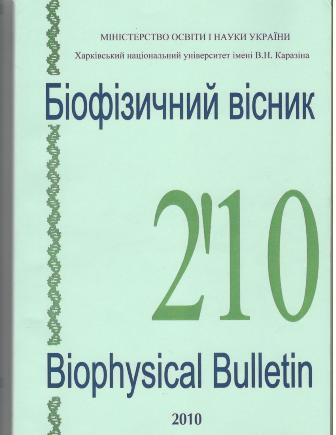Interaction of new fluorescent ICT-dyes with lipid membranes
Abstract
The present study was undertaken to evaluate the sensitivity of newly synthesized ICT dyes to the
changes in physicochemical properties of lipid bilayer. Partitioning of ICT4 into lipid phase of the model
membranes composed of zwitterionic lipid phosphatidylcholine (PC) and its mixtures with anionic lipid
cardiolipin and cholesterol was followed by the decrease of fluorescence quantum yield and shortwavelength shift of emission maximum. On the contrary, ICT2 exhibited tenfold increase of the quantum yield upon interaction with liposomes, without any shift of the emission maximum. Analysis of the partition coefficients showed that inclusion of cardiolipin and choleterol into phosphatidylcholine bilayer gives rise to increase of the ICT2 incorporation into lipid phase compared to the neat phosphatidylcholine membrane.
Downloads
References
2. Lakowicz J.R. Principles of fluorescent spectroscopy. Springer: Singapore. 2006.
3 Xu Z., Xiao Y., Qian X., Cui J., Cui D. Ratiometric and selective fluorescent sensor for CuII based on internal charge transfer (ICT) // Org. Lett. 2005. V. 7(5). P. 889-892.
4. Mause M. Photoinduced intramolecular charge transfer in donor-acceptor Biaryls and resulting applicational aspects regarding fluorescent probes and solar energy conversion // IBBN: 1-58112-030-3.
5 Lin L.R., Li Z., Yang W.L., Chen H., Jiang Y.B. Intramolecular charge transfer dual fluorescence pH sensing using p-dibutylaminobenzoic acid-β-cyclodextrin inclusion complex // Chin. Chem. Lett. 2003. V. 14(5). P. 495 – 498.
6. Čmiel V., Mravec F., Halasová T., Sekora J., Provazník I. Emission properties of potential-responsive probe Di-4-ANEPPS // Analysis of Biomedical Signals and Images. 2010. V. 20. P. 359 - 363.
7. Pal S.K., Sukul D., Mandal D., Bhattacharyya K. Solvation dynamics of DCM in lipid // J. Phys. Chem. B. 2000. V. 104. P. 4529 - 4531.
8. Koehorst R.B.M., Spruijt R.B., Hemminga M.A. Site-directed fluorescence labeling of a membrane protein with BADAN: Probing protein topology and local environment // Biophys. J. 2008. V. 94. P. 3945 – 3955.
9. Koehorst R.B.M., Laptenok S., van Oort B., van Hoek A., Spruijt R.B., van I.H.M. Stokkum, van Amerongen H., Hemminga M.A. Profiling of dynamics in protein–lipid–water systems: a time-resolved fluorescence study of a model membrane protein with the label BADAN at specific membrane depths // Eur. Biophys. J. 2010. V. 39. P. 647 – 656.
10. Haidekker M.A., Brady T.P., Lichlyter D., Theodorakis E.A. Effects of solvent polarity and solvent viscosity on the fluorescent properties of molecular rotors and related probes // Bioorg. Chem. 2005. V. 33. P. 415 – 425.
11. Loutfy R.O. Fluorescence probes for polymer free-volume // Pure Appl Chem. 1986. V. 58. P. 1239 – 1248.
12. Kung C.E. Reed J.K Microviscosyty measurements of phospholipid bilayers using fluorescent dyes that undergo torsional relaxation // Biochem.1986 V.25. P. 6114 – 6121.
13. Lukac S., Thermically induced variations in polarity and microviscosity of phospholipid and surfactant vesicles monitored with a probe forming an intramolecular charge-transfer complex // Am. Chem. Soc.1984. V. 106. P. 4386 – 4392.
14. Haidekker M.A., Heureux N. L., Frangos J.A., Fluid shear stress increases membrane fluidity in endothelial cells: a study with DCVJ fluorescence // Am. J. Physiol. Heart Circ. Physiol. 2000. V. 278. P. 401 – 406.
15. Mui B., L. Chow L., Hope M.J. Extrusion technique to generate liposomes of defined size // Meth. Enzymol. 2003. V. 367.P. 3 - 14.
16. Bartlett G. Phosphorus assay in column chromatography // J. Biol. Chem. 1959.V. 234.P. 466 - 468.
17. Santos N.C., Prieto M., Castanho M.A.R.B. Quantifying molecular partition into model systems of biomembranes: an emphasis on optical spectroscopic methods // Biochim. Biophys. Acta. 2003. V. 1612. P. 123 - 135.
18. Heerklotz H., Binder H., Lantzsch, G. Klose G., Blume A. Lipid/detergent interaction thermodynamics as a function of molecular shape // J. Phys. Chem. 1997. V. 101.p. 639 - 645.
Authors who publish with this journal agree to the following terms:
- Authors retain copyright and grant the journal right of first publication with the work simultaneously licensed under a Creative Commons Attribution License that allows others to share the work with an acknowledgement of the work's authorship and initial publication in this journal.
- Authors are able to enter into separate, additional contractual arrangements for the non-exclusive distribution of the journal's published version of the work (e.g., post it to an institutional repository or publish it in a book), with an acknowledgement of its initial publication in this journal.
- Authors are permitted and encouraged to post their work online (e.g., in institutional repositories or on their website) prior to and during the submission process, as it can lead to productive exchanges, as well as earlier and greater citation of published work (See The Effect of Open Access).





